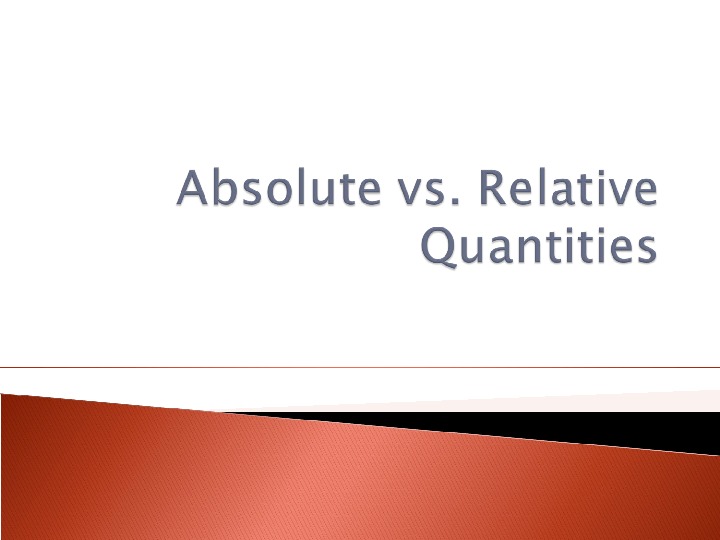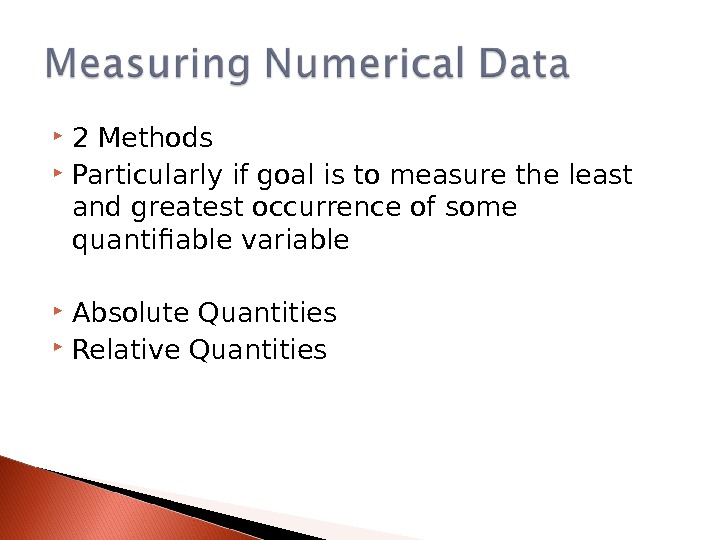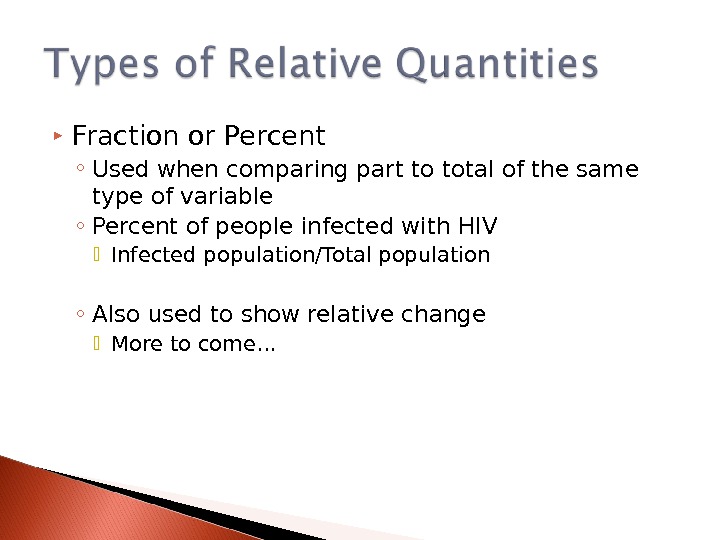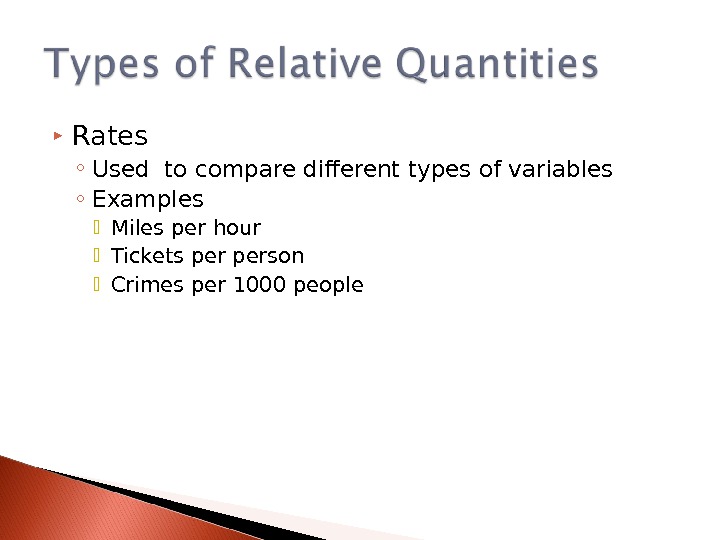2 Methods Particularly if goal is















- Размер: 2 Mегабайта
- Количество слайдов: 14
Описание презентации 2 Methods Particularly if goal is по слайдам

 2 Methods Particularly if goal is to measure the least and greatest occurrence of some quantifiable variable Absolute Quantities Relative Quantities
2 Methods Particularly if goal is to measure the least and greatest occurrence of some quantifiable variable Absolute Quantities Relative Quantities
 Measure of the absolute occurrence of the variable A “sheer” number Tells how many or how much Examples ◦ Number of students enrolled at De. Paul ◦ Number of people in this class ◦ Number of babies born this year
Measure of the absolute occurrence of the variable A “sheer” number Tells how many or how much Examples ◦ Number of students enrolled at De. Paul ◦ Number of people in this class ◦ Number of babies born this year
 An absolute quantity divided by some other quantity Calculated value Tells percent, rate, fraction or ratio Examples: ◦ Ticket sales person ◦ Percentage of population infected with HIV by country ◦ Percent increase in population by state
An absolute quantity divided by some other quantity Calculated value Tells percent, rate, fraction or ratio Examples: ◦ Ticket sales person ◦ Percentage of population infected with HIV by country ◦ Percent increase in population by state
 Fraction or Percent ◦ Used when comparing part to total of the same type of variable ◦ Percent of people infected with HIV Infected population/Total population ◦ Also used to show relative change More to come…
Fraction or Percent ◦ Used when comparing part to total of the same type of variable ◦ Percent of people infected with HIV Infected population/Total population ◦ Also used to show relative change More to come…
 Ratio ◦ Used to compare the same type of variable from two sources ◦ Example: California’s population is 33, 872, 000 Oregon’s population is 3, 421, 000 How many times larger is CA than OR? Divide CA/OR = 9. 90 CA is almost 10 times larger
Ratio ◦ Used to compare the same type of variable from two sources ◦ Example: California’s population is 33, 872, 000 Oregon’s population is 3, 421, 000 How many times larger is CA than OR? Divide CA/OR = 9. 90 CA is almost 10 times larger
 Rates ◦ Used to compare different types of variables ◦ Examples Miles per hour Tickets person Crimes per 1000 people
Rates ◦ Used to compare different types of variables ◦ Examples Miles per hour Tickets person Crimes per 1000 people
 Let’s work with some absolute and relative quantities HIV_Adults_By_Country_2001. xls State. Lotteries. xls
Let’s work with some absolute and relative quantities HIV_Adults_By_Country_2001. xls State. Lotteries. xls
 Describes the actual increase or decrease from a reference (or old/earlier) value to a new (or later) value Formula ◦ Absolute Change = new value – reference value
Describes the actual increase or decrease from a reference (or old/earlier) value to a new (or later) value Formula ◦ Absolute Change = new value – reference value
 Compares the absolute change to the reference value Formula ◦ Relative Change = Absolute Change Reference Value or = new value — reference value ◦ Convert relative change from fraction to % (with 2 decimal places) for readability purposes
Compares the absolute change to the reference value Formula ◦ Relative Change = Absolute Change Reference Value or = new value — reference value ◦ Convert relative change from fraction to % (with 2 decimal places) for readability purposes
 Absolute and Relative Change
Absolute and Relative Change
 Already discussed ◦ Percent Change Formula = (new-old)/old ◦ Percentage of Main Formula is part/whole=% ◦ Absolute Change Formula = new value – reference(old) value ◦ Relative Change Formula = Absolute Change/Reference Value
Already discussed ◦ Percent Change Formula = (new-old)/old ◦ Percentage of Main Formula is part/whole=% ◦ Absolute Change Formula = new value – reference(old) value ◦ Relative Change Formula = Absolute Change/Reference Value
 Percent More Than or “Times More Than” ◦ Example: The life expectancy in Canada is 79. 1 years; the life expectancy in the US is 76. 0 years. ◦ By how many percent is the life expectancy in Canada higher than the life expectancy in the US? Answer — find percent change (79. 1 -76. 0)/76. 0 = 0. 041 or 4. 1% ◦ How many times as large is the life expectancy in Canada than the life expectancy in the US? Answer – divide Canada LE/US LE 79. 1/76. 0 = 1. 041 times larger
Percent More Than or “Times More Than” ◦ Example: The life expectancy in Canada is 79. 1 years; the life expectancy in the US is 76. 0 years. ◦ By how many percent is the life expectancy in Canada higher than the life expectancy in the US? Answer — find percent change (79. 1 -76. 0)/76. 0 = 0. 041 or 4. 1% ◦ How many times as large is the life expectancy in Canada than the life expectancy in the US? Answer – divide Canada LE/US LE 79. 1/76. 0 = 1. 041 times larger
 Percent Less Than Same Example: The life expectancy in Canada is 79. 1 years; the life expectancy in the US is 76. 0 years. ◦ By how many percent is the life expectancy of people in the US lower than the life expectancy in Canada? Answer – find percent change but divide by Canadian LE (76. 0 -79. 1)/79. 1 = -0. 039 or -3. 9%
Percent Less Than Same Example: The life expectancy in Canada is 79. 1 years; the life expectancy in the US is 76. 0 years. ◦ By how many percent is the life expectancy of people in the US lower than the life expectancy in Canada? Answer – find percent change but divide by Canadian LE (76. 0 -79. 1)/79. 1 = -0. 039 or -3. 9%

